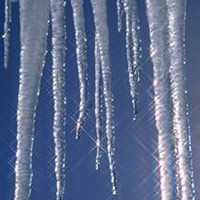Lifestyle Column: 10 Neat Things

This week: 10 neat things about freeze up.
1. Staying alive, staying alive, uh, oh, oh, staying alive. As the temperature plunges, the earth begins to freeze — well, not exactly the earth, but the water in the earth and even in the rocks in the earth. Staying alive becomes the critical compulsion for all living things. Some animals and insects hibernate or go into a period of aestivation. People put on woolies and retreat to warm houses. Plants however, cannot get up and find a protected place. They have to find other ways to stay alive.
2. Pore ice, segregated ice. When water freezes between molecules of soil, it's called pore ice. Pore ice can attract more water, eventually turning the ice into a solid layer of ice called segregated ice. This can be as much as 10 feet thick and there's not much a plant can do to combat this. Fortunately, for most of us and our plants, pore ice is all we have to deal with.
3. When ice crystals form. Liquid water is denser than frozen water. Freezing water expands with great force, as the ice crystals form. It is this expansion that causes the damage to plant cells, which can rupture thanks to the pressure of expanding ice crystals. This is also why ice floats. It's also why we have frost heave humps and potholes in our pavement.
4. Not all soils freeze equally. Sandy soils, loose soils, and soils made up of large particles freeze easily because they have more space for water between the particles. Clay takes longer to freeze. Nor is all frozen ground the same temperature. Soil near the surface can be colder or warmer depending on the environment. If the sun is shining, surface soils may become warm, while soils lower down may remain colder, but soil will only freeze to a certain depth. Go deeper and deeper and suddenly the earth begins to warm up again, thanks to the heat rising from the earth's molten core. This is why geothermal technologies work.
5. Light or dark? Light coloured soils freeze sooner than darker ones. Light coloured soils also reflect the sunlight away from the earth so they stay cooler longer.
6. Coping with all this trauma. Cold-hardy plants produce chemicals that help regulate or inhibit the formation of ice crystals. Included in the plant strategy for cold weather survival are abscisic acid (ABA), gibberllins and antifreeze proteins. Gibberllins are plant hormones that regulate a number of plant functions including growth, flowering, germination and dormancy. Antifreeze proteins are polypeptides that help protect plant cells by inhibiting the growth of crystals. ABA is another hormone that performs a number of complementary and sometime antagonistic functions related to dormancy and the management of seed germination. ABA has been implicated in the reduction of inflammation in humans.
7. Go to sleep. Go deeply to sleep. Once the process of dormancy is started it must continue for the period of time required by that particular plant, during which chilling must take place. If this does not happen, the plant will die. Dormancy can be triggered by a reduction in light and a drop in temperature, usually between 0 and 10 degrees Celsius.
8. All temperate climate plants need to sleep. Dormancy is necessary for temperate climate plants to survive. Eternal summer is not only stressful, it can't be induced indefinitely. A Japanese maple was exposed to two years of growth under lights, at which time, it automatically went dormant.
9. Plant beside a river. The ground near rivers, lakes and volcanoes is warmer because heat spreads from them into the nearby earth.
10. Drunken forests. In discontinuous permafrost, trees can be seen leaning in random directions like a lot of drunken soldiers. This is due to the melting of the permafrost which causes the earth to partially release its hold on the roots.
Copyright© Pegasus Publications, Inc.
Dorothy Dobbie is the author of 10 Neat Things, published by Pegasus Publications and is a new contributor to KBR.